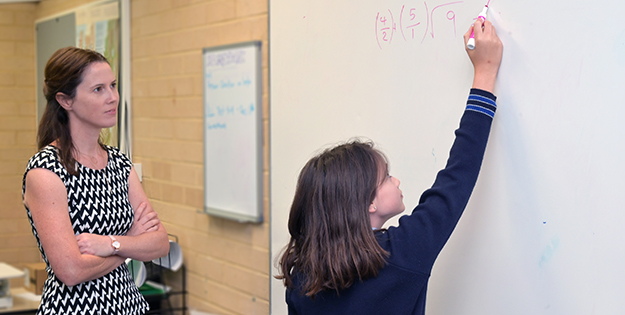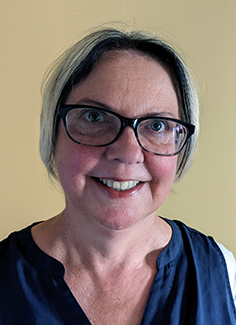Global
Copyright@ Australian Catholic University 1998-2025 | ABN 15 050 192 660 CRICOS registered provider: 00004G | PRV12008
Copyright@ Australian Catholic University 1998-2025 | ABN 15 050 192 660 CRICOS registered provider: 00004G | PRV12008

It’s a familiar situation in households across Australia: the moment of dread felt by maths-avoidant parents asked to help their kids with the tricky tasks and worksheets they bring home from school. Of equal concern is that many schoolchildren experience similar levels of anxiety and dread when it comes to doing maths. International data shows that Australian students’ performance in mathematics has been on a downward spiral for two decades, a signal that the subject’s unfortunate reputation as difficult and boring may be having a negative effect on maths engagement.
“We’ve long had to deal with these myths and misconceptions that mathematics is just too hard for some people, and these beliefs can interfere with our ability to learn and enjoy maths as a subject,” says educator and researcher Tracey Muir, Professor in Education (STEM) at ACU.
“Even in this day and age, there’s this idea that you either have a ‘maths brain’ or you don’t, which we know is not true. But we’re still seeing students who think they’re no good at maths, and who fear being put on the spot and humiliated for being wrong, and that makes them afraid to speak up in maths classes.”
That’s a worry because gaps in mathematical knowledge are almost impossible to bridge without engagement.
“The gaps just get wider and wider as these students go through primary school and enter high school,” says Professor Muir, whose research is focused on the effective teaching of numeracy and student engagement in mathematics.
“What we find is that they start to engage in behaviours that aren’t thinking behaviours in class – so they might be swinging back on their chair, for example, and not doing any work, or they’re writing something down and then rubbing it out but they’re not actually getting into the maths.”
Professor Muir suggests these “non-thinking behaviours” may be contributing to the widespread decline in maths performance. In a piece written for The Conversation, she explores the phenomenon alongside Professor Peter Liljedahl, author of the best-selling book, Building Thinking Classrooms in Mathematics.
Studies by both researchers indicate that the four main non-thinking behaviours – slacking, stalling, faking and mimicking – are all too common in a typical hour-long lesson.
Slacking is described as not attempting to work at all; stalling involves avoiding engagement through a legitimate off-task behaviour, like sharpening a pencil; and faking is where a student pretends to do a task but achieves nothing. The fourth behaviour, mimicking, is perhaps the most interesting as it does involve an attempt to work on a task but is nonetheless classified by Liljedahl and Muir as non-thinking.
In many Australian classrooms, maths lessons follow a familiar pattern formed by a series of steps that are so ingrained they’re almost script-like. Sometimes known as the “now you try one” method or the “I do, we do, you do” pattern, it involves the teacher demonstrating a maths problem to the class, then leading the class in working on a similar problem, before finally asking the students to work on the task by themselves.
In this scenario, students who engage in mimicking often arrive at the correct answer; however, Liljedahl and Muir argue that they do so simply by referencing and copying prior examples, meaning they rarely form a conceptual understanding of the problem at hand.

“If students are just following a procedure that has been demonstrated to them, it’s actually the teacher who is doing most of the thinking,” says Professor Muir, adding that students who engage in mimicking often believe it is what their teacher wants to see.
“As maths teachers, we should be looking for evidence of divergent and creative thinking in our students, not just mimicking and following on. We want to facilitate what we call ‘productive struggle’, where the answer isn’t immediately obvious to the student, so they have to rise to the challenge and struggle through it.”
She cites the term “zone of confusion”, attributed to Professor Peter Sullivan, whereby a student is temporarily unsure of how to proceed with a challenging problem, which is a crucial part of the process of doing mathematics.
“Sometimes as teachers, we want to take that struggle away, to make it more comfortable for our students, but it’s only through the struggle that they start to grapple with the problem and form a true understanding of it,” she says.
“If you give them a challenging task and encourage them to persist and have a go, that facilitates thinking behaviours. It’s not a sign of failure to get things wrong in the process of solving a problem, it’s a strategy for learning and actually engaging in mathematical thinking.”
So, how do we encourage true engagement with mathematics in school classrooms?
Research in this area indicates that non-thinking behaviours often occur when teachers are doing most of the talking and directing, in what is broadly termed “direct instruction” or “chalk and talk” teaching.
“The work of Peter Liljedahl raises the point that little has changed since the industrial age of education, where it’s typically still the teacher up the front doing the teaching while the students are sitting there, passively taking in the information,” says Professor Muir, who worked as a teacher before moving into academia.
“This conventional, instructional style of teaching tends to persist more in maths classrooms than in many other subjects, and unfortunately, the evidence shows that it encourages non-thinking behaviours by the very way the classroom is set up.”
As Professor Liljedahl discovered when he first started investigating non-thinking behaviours, entrenched classroom norms can be difficult to break.
Thankfully, some recommended adjustments to teaching approaches can help to promote student thinking behaviours, says Professor Muir. These strategies can transform how students feel about maths, while also boosting their ability to engage in mathematical thinking.
In their recent piece, Muir and Liljedahl cite two evidence-based ideas for enhancing engagement in maths classroom: forming small, randomised groups; and getting students to stand up to work on maths problems.
The latter is particularly effective in that standing can eliminate slacking, stalling and faking behaviours, as was pointed out by one student who participated in Professor Muir’s study.
“Standing helps me concentrate more because if I’m sitting down I’m just fiddling with stuff,” the student said, “but if I’m standing up, the only thing you can do is write and do maths.”

The researchers say that groups of three students standing together and working on a whiteboard is ideal for promoting thinking behaviours for various nuanced reasons; for example, the non-permanent nature of whiteboards prompts students to take more risks, increasing participation, while the lack of a detailed written example promotes deeper concentration and engagement. Providing a verbal account of the problem to be solved also requires students to engage in thinking rather than passive behaviour.
“When you have students standing up to hear the instructions rather than having a written problem to read over and refer to, they’re actively engaged in listening in order to develop an understanding,” Professor Muir says. “The whiteboard can be used to provide little prompts to help them along, but they still don’t see the problem written down, so they really have to concentrate, which is another clear benefit.”
The group nature of this approach is valuable, the researchers add, as students take collective responsibility for solving problems. Professor Liljedahl describes the “thinking classroom” as a place where individuals are “learning together, and constructing knowledge and understanding through activity and discussion”.
The way these groups are formed is also important. Self-selected and teacher-nominated groups can have varying effects on individuals, with the confident maths learners taking a leading role, and others “living down” to expectations. Conversely, when groups are formed randomly, students tend to be more willing to collaborate, with increased enthusiasm for mathematics learning.
“When there’s collective responsibility for solving a problem, the engagement increases and it’s very visible, so you can see exactly what everybody is doing,” Professor Muir says.
“I like to use the term, ‘making mathematical thinking visible’, because if I’m a teacher, I want to see what their thinking is, how they’re going about solving a problem, and that can help to counteract the perception that there’s one ‘right way’ to do a maths problem. There might be one correct answer, but in many cases there are lots of ways you can get to that answer.”
Overall, the researchers contend that in a thinking classroom, students must be given something to think about.
“There are lots of different ways of teaching maths effectively, and the key thing is that you teach for conceptual understanding, and give students tasks that are worth thinking about,” Professor Muir says.
“It’s the teacher that has the pedagogical content knowledge, but rather than just giving the students a recipe to follow, they need to help them to think for themselves as they come to an understanding of the problem. That can be challenging and it can be a struggle, but at the end of the day, it helps students to learn and to get value out of that learning, and they are more likely to then start seeing maths not as boring and difficult, but as engaging and fun.”
Tracey Muir is Professor in Education (STEM) at ACU. She researches effective teaching of numeracy and student engagement in mathematics, including making mathematical thinking visible, mathematical talk in early years classrooms, online engagement and personalised learning.

Passionate about education? Explore the options.
Copyright@ Australian Catholic University 1998-2025 | ABN 15 050 192 660 CRICOS registered provider: 00004G | PRV12008